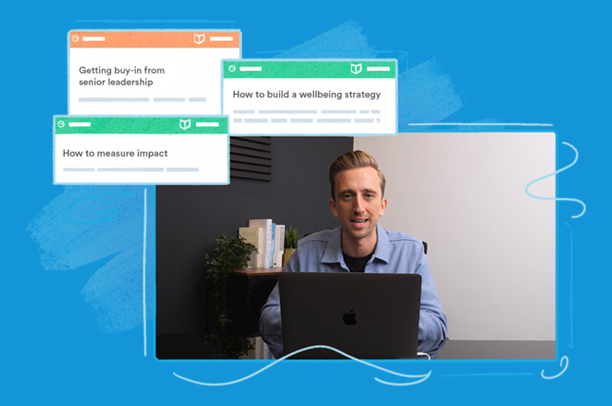Mental health and wellbeing in the workplace is becoming a growing priority for many business leaders and HR professionals. Despite this, many employees still do not feel comfortable speaking with their manager about any mental health problems they may be currently facing. This is largely due to fear of jeopardising their reputation at work or prompting future issues. Understanding the issue is one thing, but knowing how to promote positive wellbeing and support those experiencing mental health issues is another.
Implications of Workplace Mental Ill-Health
Whilst it is a difficult task to help struggling employees, it is an employer’s responsibility to create a workplace where employees feel they can be open. To effectively manage employees with mental health issues, little to no action can lead to implications in work performance, the environment and overall health in the workplace.
In 2019, a study conducted by the Mental Health Foundation discovered 45% of employees were diagnosed with a mental health issue. Those who had taken time off work, as a result, gave a different reason for doing so. This goes to show employees with mental health issues are still stigmatised in the workplace.
In an earlier study in 2018 by Public Health England, data presents one-third of productivity was lost due to work-related stress and mental health at work problems. Lifestyle choices we make can also contribute, however, lost productivity and absence can cost the UK economy a whopping £80bn.
The Need Of Human Connection For Wellbeing
In the prevention of mental health problems in the workplace, employers can use the power of basic human connection. Mental health problems aren’t the fault of anyone. No one chooses to have depression or anxiety. However, workplace stress can be managed and controlled with the correct interventions.
Employees who have a workplace buddy are seven times more likely to be engaged and productive at work than those who do not. Experiencing mental health at work issues can be easily supported through the ability to smile, laugh and socialise with our peers. These can be managers or colleagues.
How To Manage Employees With Mental Health Issues
When considering how to manage employees with mental health issues, there are many key components to consider. There is no ‘one size fits all’ approach however the suggestions we will discuss in this article will help you take the right approach and create a truly supportive culture.
If you’re looking to assess the mental health risks within your workplace including workplace anxiety and stress, we recommend using our free workplace mental health risk assessment template just here.
Under the Health and Safety at Work Act 1974, every employer has a duty to ensure that, so far as is reasonably practicable, the health, safety and welfare of employees are protected. Employers must conduct a risk assessment to identify the measures necessary to comply with the Act and other regulations.
One key component is creating a safe space for employees to open up, which means tackling mental health stigma in the workplace. The impact of this can be huge and even help influence other key areas such as; flexible working, performance management and extended resources.
Create Virtual Water Cooler Moments
Working from home has removed the human element in our occupational lives, however it needn’t fade entirely. Coffee-break chat can still exist, albeit through a computer screen. This may lose the touch of eye contact but start by making time and committing to connecting colleagues together virtually, away from work-related chat.
The people we surround ourselves with help to create happy workplace environments, leading to increased performance and overall mental health in the workplace. Not only do our colleagues look out for us, human connection also helps improve overall performance and morale.
Make Listening Your Superpower
Contrary to popular belief, a mental health strategy doesn’t need to comprise of yoga sessions and free mental health support. Whilst these perks are inherently beneficial to many employees, economically they can jar with company budgets. Instead, to manage employees with mental health issues give the gift of time through the power of listening.
Listening can be done through the employees’ line manager, senior managers or colleagues alike. When an employee feels compelled to discuss their mental health issues, chances are it weighs on the following factors:
- What resources do I have available to me?
- Will my employer be supportive?
- How open is my workplace to mental health issues?
Actively listening to employees not only helps destigmatise mental health problems in the workplace but it also acts as a catalyst for prevention. It is important to remember, employees won’t expect their manager to check in or understand every mental health condition, employers are not psychotherapists. Therefore there shouldn’t be pressure from either management or employees to adopt this role at work.
However, listening with empathy is a key pillar in a workplace wellbeing strategy. Encourage all employees to be willing and open to listen to a colleague who is experiencing mental health issues or stress. This strengthens workplace bonds and enables managers to have a better understanding of employee wellbeing.
How Do I Manage Employees With Mental Health Issues?
It is believed one in six of employees are experiencing mental health issues at any one time in the workplace. So chances are if it’s not you, it could be your colleague or your manager. Whilst not everyone feels comfortable talking about personal health issues, it is imperative workplaces are informed of the varying forms of mental ill-health, simply by raising mental health awareness across the business.
Make Adjustments
Anxiety and depression affect people in different ways so it is important to remember to take a personal approach with different employees. Some may appreciate, and require, adjustments made to the workplace or their job so that they are able to continue in their role. Whilst others may require time off to visit therapy appointments, recalibrate and return to work with a fresh mindset. Some employees facing certain conditions such as bipolar might prioritise exercise or connecting with their family. This might require them to finish work earlier to collect their children from school or go to the gym. Flexible working might be of value to some members of staff. To explore your options, we recommend employers run an anonymous survey to collate data and understand where employees hold value for their wellbeing at work.
Employers should ensure that employees are fully supported to remain or return to work as they wish, and that returning to work will be a smooth process for them and other team members.
Use Work To Their Advantage
On the contrary, work can play a significant role for someone facing anxiety or depression. Workplaces offer us a sense of belonging, purpose and provide us with structure, routine and social life. A bout of anxiety whilst signed off work can leave the individual in a worse state of overwhelm, than if their mind is occupied with work.

Look For Changes In Behaviour
Once you are aware of someone experiencing a mental health challenge, it is inherently easier to spot changes in their behaviour in the future. It is not always easy for someone who is struggling to open up and whilst behaviour differs from person to person, key changes in behaviour include:
- Appearing restless, tense or on edge
- Avoiding certain workplace activities such as meetings or socials
- Keeping the camera off during video calls
- Becoming overwhelmed or upset easily
- Difficulty making decisions
- Difficulty making deadlines
- Appearing worried or apprehensive
- Arriving late to work
- Appearing disconnected and or absent at work
- Being vulnerable to stress or anxiety
- Falling into bad habits such as drinking or smoking
- Loss of confidence
- Low self esteem
- Negative thought patterns
The aforementioned could help enable change within the business and support managers who could better manage employees with mental health issues. It is important employers do not try to explain how they might be feeling or try to diagnose them. They might already be aware of their situation and out of fear are worried to raise the subject with you.
Try approaching them with a simple question such as, “I’ve noticed a couple of deadlines have been missed, can I help with anything?” or, “I’ve noticed you’re quieter than usual during our staff meetings, is everything ok?”.
Actively listening to an employee, taking on board what they are feeling and facing is extremely important to their recovery and their performance at work. By reminding them you are there for support, but they are in control can go a long way to helping someone be more solution-focused whilst their current vision is cloudy.
Invest In Up-To-Date Management Training
The best way to support and manage employees with mental health challenges is to prevent issues before they arise and reach a level of crisis. Crisis can include employee absences, although are not limited too. Mental health challenges at work can also present itself in the form of absenteeism, whereby the employee is physically in work but not focused on their role, or their environment, respectively.
This means fostering a culture that promotes positive mental health and wellbeing in the workplace as opposed to supporting those who are already suffering. In doing so, up-to-date management training is vital. As we previously mentioned, managers needn’t be experts in the field of mental health issues, but by providing them with the correct information they’re able to tackle issues head on with solid solutions.
Training surrounding mental health can be done internally by making management aware of internal processes, benefits and mental health support available and how this can be communicated across the business. If an employee is facing mental health problems for the first time, they may not know what works for them – therefore learning about new resources available to them could be extremely useful.
Furthermore, in-depth mental health awareness training can be made through external bodies such as Mental Health First Aid. Further information on such courses can be found on our website here.
Commit to Social Activities
It is easy to offer the idea of social activities for employees but how long do these initiatives stick once the idea has been agreed? In the same way colleagues gather around a water cooler to chat, employees like to know their employer also supports healthy working relationships. Whilst these can be formed in the workplace, employee wellbeing can also benefit from social circles away from a working environment.

Delegate Where Needed
Too many deadlines can be overwhelming for those of us not facing mental health challenges, however, for those that do, this can become extremely stressful.
Share deadlines where you can and communicate to team members what needs to be shared. By breaking down large projects into smaller components it can reduce the input of extra stressors. With the addition of short-term deadlines, suffering employees can see smaller tasks as manageable which helps with productivity and their overall wellbeing.
Remain Positive
It’s very hard to see and think clearly when we’re faced with a mental health issue, therefore, it is likely the person suffering is self-critical. They might have missed deadlines or received low performance stats. However, it is really important, as a leader, you focus on the positives of the situation.
Motivation diminishes when employees face anxiety or depression as the bulk of their energy focuses on day-to-day survival. Check in with them, explain the positive outcome of completing a task as opposed to instilling fear in them by sharing the implications of an unfinished project.
Remember why you hired them. Look to their strengths during these moments and focus on the tasks they do well. It is likely they hold more value on the tasks they are strong at. When an employee feels useful and beneficial, they become more interested in completing the task which can, in turn, see an increase in productivity and a happier team.
How Do I Deal with An Emotionally Unstable Employee?
Along with adopting a coherent cross-business strategy, when it comes to emotions your strongest ally is to be kind. Pay attention to the smaller things, what triggers them? Collect information from these incidents and try to understand their situation as best you can.
Once you have figured out what might be wrong, you’re in a stronger position to address the situation. Set up a one-to-one meeting with them and establish the best course of action. It might be they wish to seek professional help and follow up regularly on their journey.
It might be that they resist the urge to talk about the issue or face it. In this instance, express your concerns the effect it is having on their role and the business. As an employer or HR professional, it is your duty to address and resolve workplace issues, however, it is also the employees’ responsibility to take control of their individual situations too.
Can Someone Be Fired For Having Mental Health Problems?
No, they can’t. Under the Equality Act 2010, there are legal obligations to reduce any negative impact on employees due to mental health at work. These are in place to safeguard the rights of those with mental health conditions. These obligations include:
- Making reasonable changes to enable employees can perform their duties effectively and can fulfill the core requirements of the role.
- Removing risks that might contribute to employees’ health and safety.
- Ensuring any conversations concerning mental health are strictly confidential and information is not disclosed without the employee’s consent.
- Ensuring the workplace does not take adverse action against an employee. To discriminate against, harass or victimise people with disabilities is unlawful, and mental health problems are included in this.
Takeaways
Prevention is better than cure. To effectively manage employees with mental health issues the key is to create a positive and happy work environment. Toxic workplaces are breeding grounds for stress and mental ill-health. First and foremost, be open and honest with your employees, this opens up many avenues for you to understand them better and builds strong relationships and workplaces.
Can we help? Everymind’s mission is to destigmatise the conversation around mental health in the workplace through the use of technology. Our handy app is available to all employees, for free, across your business. Think of us as a therapist in your pocket, 24/7. More information and how to sign up can be found here.








